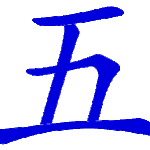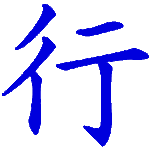The 5 phases of change (eng: 5 elements, chi: wǔxíng): Wood – Fire – Earth – Metal – Water can be represented as the climatic course of the year:
In spring, the wood grows and the new farming year begins. In summer the sun burns, it is the time of fire and perseverance. The soil is ready for the harvest season in late summer, and the produce is gathered. Metal stands for autumn, the harvest has been brought in, a good harvest brings wealth. Water stands for winter, it is the time for rest, analyzing the year and planning for the New Year.
A second representation is according to the 4 cardinal points. The focus is on the earth. Wood for the east: the sun rises and the plants open up, there is dew on the plants or the fog slowly disappears. Fire for the south: the sun is at its zenith, it’s hot and dry. Metal for the west: the sun goes down, it gets cool and gray. Water for the north: it’s dark, no sun and therefore no warmth.
The phases of change have 4 different cycles. These are:
| Cycles: | Other designations: | Remarks: |
| Feeding cycle | Transformation cycle Generation cycle | Natural cycle |
| Overcoming cycle | Control cycle Destruction cycle | Control cycle according to Strunz |
| Mockery cycle | Control cycle | Control cycle according to Kubny |
| Weakening cycle |
Please note that there is often confusion in the terms used in German texts. Please read the corresponding description carefully.
In the feeding cycle, the natural cycle of nature, wood gives food to fire, fire with its ashes gives food to the earth, metal is created in the earth, where there is metal there is also water and water makes wood grow.
If the phases of change in a person are not balanced, this leads to imbalances in character, health, etc:
The overcoming cycle can work by wood piercing the earth with its roots, fire melting metal, earth constricting water, metal cutting wood and water extinguishing fire. The mockery cycle runs counter to the overcoming cycle (also known as the control cycle). So earth suffocates weak wood, weak fire cannot melt metal, water breaks through weak earth, wood dulls weak metal and fire vaporizes weak water.
In the weakening cycle, which runs counter to the feeding cycle (also known as the transformation cycle), wood draws energy from water, fire consumes wood to burn, the earth suffocates fire, metal permeates the earth and water quenches the metal.
Together with Qi, Yin and Yang, this method is the basis for TCM, nutritional advice according to TCM (5-elements nutritional advice), Feng Shui, Bazi Suanming (eng: 4 pillars) as areas of traditional Chinese sciences (TCW).
Subsequently, forms, colors, materials, organs, senses, feelings, foods, herbs, character traits, professions, hobbies, etc. are divided into these transformation phases.
If you know which transformation phases are missing or too strong, they can be balanced by the above-mentioned classifications. Sometimes we use this unconsciously, for example by choosing a suitable profession/hobby, eating/drinking suitable foods or wearing suitable clothes (colors).
In classical Feng Shui, knowledge is used in interior design. Using the method of flying stars (eng: Flying Stars, chi: feixing) and with regard to the personality of the client and his roommates/employees, favorable transformation phases (eng: elements) are worked out.
In Bazi Suanming (eng: 4 pillars), the 5 phases of transformation (eng: 5 elements, chi: wuxing) are used in the pillars to analyze which personalities result from them and how the person achieves balance.




